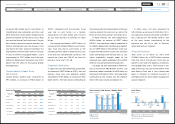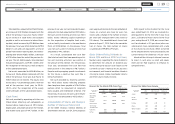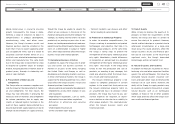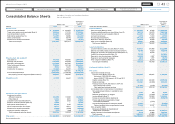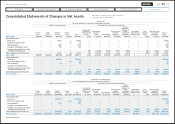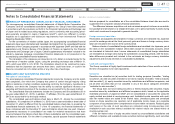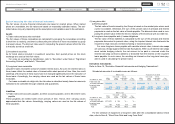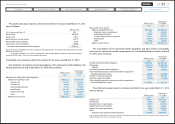Mazda 2014 Annual Report Download - page 49
Download and view the complete annual report
Please find page 49 of the 2014 Mazda annual report below. You can navigate through the pages in the report by either clicking on the pages listed below, or by using the keyword search tool below to find specific information within the annual report.
Notes to Consolidated Financial Statements Mazda Motor Corporation and Consolidated Subsidiaries
1 BASIS OF PRESENTING CONSOLIDATED FINANCIAL STATEMENTS
The accompanying consolidated financial statements of Mazda Motor Corporation (the
“Company”) and its consolidated subsidiaries (together, the “Group”) have been prepared
in accordance with the provisions set forth in the Financial Instruments and Exchange Law
of Japan and its related accounting regulations, and in conformity with accounting princi-
ples generally accepted in Japan (“Japanese GAAP”), which are different in certain
respects as to application and disclosure requirements from International Financial
Reporting Standards (“IFRS”).
For the convenience of readers outside Japan, the accompanying consolidated financial
statements have been reformatted and translated into English from the consolidated financial
statements of the Company prepared in accordance with Japanese GAAP and filed with the
appropriate Local Finance Bureau of the Ministry of Finance as required by the Financial
Instruments and Exchange Law of Japan. Certain supplementary information included in the
statutory Japanese language consolidated financial statements is not presented in the
accompanying consolidated financial statements.
The translation of the Japanese yen amounts into U.S. dollars is included solely for the
convenience of readers outside Japan, using the prevailing exchange rate at March 31,
2014, which was ¥103 to U.S. $1.00. The translations should not be construed as repre-
sentations that the Japanese yen amounts have been, could have been, or could in the
future be converted into U.S. dollars at this or any other rate of exchange.
2
SIGNIFICANT ACCOUNTING POLICIES
Principles of consolidation
The accompanying consolidated financial statements include the Company and its signifi-
cant companies, over which the Company has power of control through majority voting
rights or existence of certain conditions evidencing control by the Company. Investments in
affiliates, over which the Company has the ability to exercise significant influence over
operating and financial policies of the investees, are accounted for by the equity method.
The consolidated financial statements include the Company and 59 subsidiaries (56 in
the year ended March 31, 2013). In addition, 15 affiliates (15 in the year ended March 31,
2013) are accounted for by the equity method.
The consolidated year-end balance sheet date is March 31. Among the consolidated
subsidiaries, 15 companies (14 at March 31, 2013) have a year-end balance sheet date of
December 31, which is different from the consolidated balance sheet date. In preparing the
consolidated financial statements, for 7 of the 15 companies, the financial statements of
these companies with the December 31 year-end balance sheet date are used. However,
adjustments necessary in consolidation are made for material transactions that have
occurred between the balance sheet date of these subsidiaries and the consolidated year-
end balance sheet date. For the other 8 companies, special purpose financial statements
that are prepared for consolidation as of the consolidated balance sheet date are used to
supplement the companies’ statutory financial statements.
The difference between acquisition cost and net assets acquired is shown as consolida-
tion goodwill and amortized on a straight-line basis over a period (primarily 5 years) during
which each investment is expected to generate benefits.
Foreign currency translation
Receivables and payables denominated in foreign currencies are translated into Japanese
yen at the exchange rate at the fiscal year-end; gains and losses in foreign currency trans-
lation are included in the income of the current period.
Balance sheets of consolidated foreign subsidiaries are translated into Japanese yen at
the rates on the subsidiaries’ balance sheet dates except for net assets accounts, which
are translated at historical rates. Income statements of consolidated foreign subsidiaries
are translated at average rates during the subsidiaries’ accounting periods, with the trans-
lation differences prorated and included in the net assets as foreign currency translation
adjustments and minority interests in consolidated subsidiaries.
Cash and cash equivalents
The Group considers all highly liquid investments with maturities of three months or less at
the time of acquisition to be cash equivalents.
Securities
Securities are classified as (a) securities held for trading purposes (hereafter, “trading
securities”), (b) debt securities intended to be held to maturity (hereafter, “held-to-maturity
debt securities”), (c) equity securities issued by subsidiaries and affiliated companies, and
(d) all other securities that are not classified in any of the above categories (hereafter,
“available-for-sale securities”).
The Group does not have trading securities or held-to-maturity debt securities. Equity
securities issued by subsidiaries and affiliated companies which, based on the applicable
materiality provisions of Japanese GAAP, are not consolidated or accounted for using the
equity method are stated at moving-average cost. Available-for-sale securities with avail-
able fair market values are stated at fair market value. Unrealized gains and unrealized
losses on these securities are reported, net of applicable income taxes, as a separate
component of accumulated other comprehensive income within net assets. Realized gains
and losses on the sale of such securities are computed using moving-average cost.
Available-for-sale securities without available fair market values are stated mainly at
moving-average cost.
If the fair market value of equity securities issued by unconsolidated subsidiaries and
affiliated companies and available-for-sale securities declines significantly, such securities
47
Mazda Annual Report 2014
CONTENTS
Foundations Underpinning
Sustainable Growth
Financial Section
Review of Operations
Message from Management
Introduction
Brand Value Management



